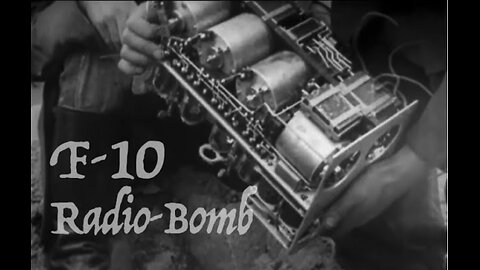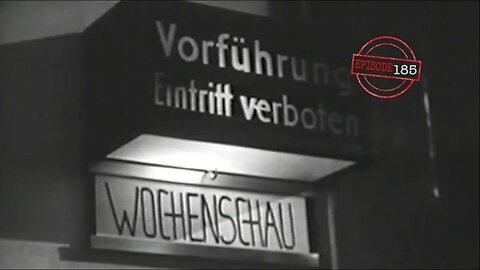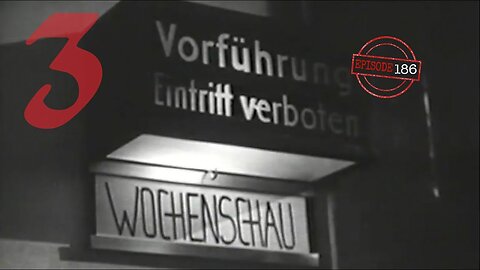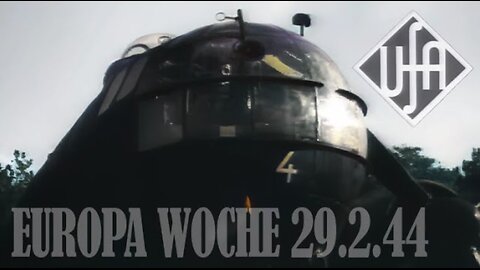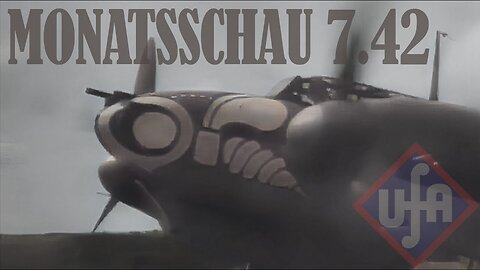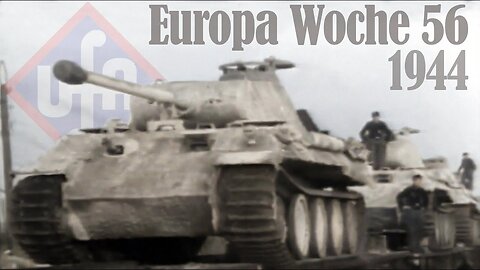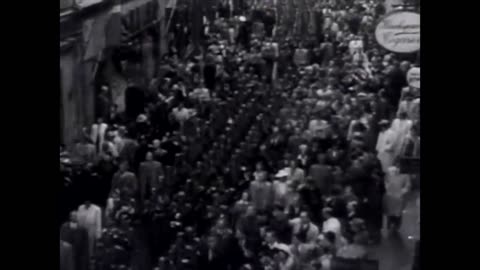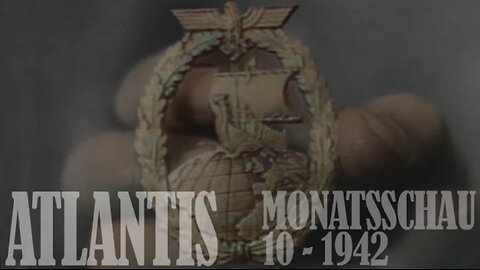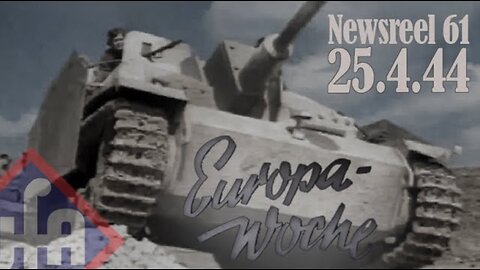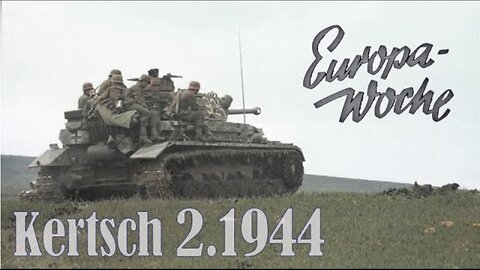
-
German Newsreel 2.1944 EUROPA WOCHE № 52 KERCH BRIDGEHEAD
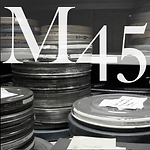 Military1945🔥PREVIEW ALL YOUTUBE VIDEOS www.Patreon.com/Military1945 Episode 286 Be sure to give this video a THUMBS UP! Best way to support the channel! Europa Woche Nr. 52 February 22, 1944 00:51 - Inauguration of Seyss-Inquart as the new President of the Germany Academy 01:42 - Report on a sawmill powered by water power 02:49 - Processing of herrings 04:18 - Performances of the Circassian dance and choir group 05:17 - German Film Ballet during training and dance rehearsal 07:26 - Four-man bobsleigh competition 08:15 - Rounding up reindeer herds in Lapland 09:24 - Celebration with young workers 10:28 - Henkell sparkling wine cellar 11:53 - German soldiers during operations against the Kerch bridgehead Battle of the Parpach Narrows, 27 February – 11 April Stavka reinforced the Caucasus Front Front with nine rifle divisions. Soviet engineers built an ice road across the frozen Kerch Strait, enabling 96,618 men, 23,903 horses and 6,519 motor vehicles to reinforce the Kerch peninsula forces. The 47th Army was deployed to the area, initially with only two rifle divisions. The Stavka created the Crimean Front under, with Kozlov as its commander, on 28 January, with the 44th, 47th and 51st Armies belonging to it organically and the Separate Coastal Army and Black Sea Fleet falling under its operational command. Kozlov had little command experience beyond the regimental level and his staff was as inept. Stavka representative Lev Mekhlis arrived at the Crimean Front HQ in late January and introduced his own ideas into the planning stage. Stalin and Mekhlis wanted to liberate Crimea with an offensive on 13 February, but the Soviet forces were unequal to the task. Soviet troops lacked food and three 76mm artillery regiments had no ammunition at all. The backward nature of the Kerch peninsula's road network, the muddy roads and the Luftwaffe's bombing campaign against ports and Soviet cargo shipping prevented a sufficient logistical buildup and made Stalin's demand unrealistic. On 27 February Kozlov finally had available for his operation the required 93,804 troops, 1,195 guns and mortars, 125 anti-tank guns, 194 tanks and 200 aircraft. These forces were assembled in nine rifle divisions at the front along with numerous tank brigades containing T-26, T-34 and 36 KV-1 tanks. The Soviets were far from ready. Their tanks and aircraft lacked fuel supplies, many weapons did not work, the Soviet artillery had not organized a fire system, communications between Kozlov's HQ and the Crimean Front armies were repeatedly cut off, and engineers had not constructed field works of any kind. Under pressure from Stalin, Kozlov started his attack anyway. First Offensive, 27 February – 3 March The 51st Army planned to attack in the north on 27 February across a flat, 80-square kilometer plain dotted only by a handful of small villages. The Germans fortified the villages of Tulumchak, Korpech’ [ru], and Koi-Asan. The German 46th and 132nd Infantry Divisions held the XXXXII Corps front along with the Romanian 18th Infantry Division. Gruppe Hitzfeld waited in reserve. The Axis defensive preparations were extensive and in accordance with German tactical doctrine. Reinforced German strongpoints had all-around defenses, neutralizing the effects of simultaneous Soviet frontal and flank attacks, and the Germans created a system of engineering works permeated with augmented artillery fires. Mattenklott made the mistake of putting the Romanian 18th Infantry Regiment into a difficult and exposed position in a salient on the northern part of the line. The Soviet planners, led by Tolbukhin, failed to account for the warm weather that turned the terrain into a sea of mud. 51st Army's offensive kicked off at 0630 hours on 27 February with a 230-gun artillery preparation of which most were light 76 mm guns and only 30 were heavy 122 mm guns. The fortified German strongpoints were largely unharmed by the light high-explosive rounds. German artillery responded with its own fire and the Soviets lacked the counter-battery capabilities to suppress them. The open terrain provided no cover for the Red Army soldiers, who were systematically killed and wounded in great numbers by incessant German artillery strikes. The heavy Soviet KV-1s sank into the mud and could not get forward. Vehicles were also stuck and Soviet artillery shells had to be carried by hand. Confused Soviet soldiers trampled their comrades to death in the mud.138 views
Military1945🔥PREVIEW ALL YOUTUBE VIDEOS www.Patreon.com/Military1945 Episode 286 Be sure to give this video a THUMBS UP! Best way to support the channel! Europa Woche Nr. 52 February 22, 1944 00:51 - Inauguration of Seyss-Inquart as the new President of the Germany Academy 01:42 - Report on a sawmill powered by water power 02:49 - Processing of herrings 04:18 - Performances of the Circassian dance and choir group 05:17 - German Film Ballet during training and dance rehearsal 07:26 - Four-man bobsleigh competition 08:15 - Rounding up reindeer herds in Lapland 09:24 - Celebration with young workers 10:28 - Henkell sparkling wine cellar 11:53 - German soldiers during operations against the Kerch bridgehead Battle of the Parpach Narrows, 27 February – 11 April Stavka reinforced the Caucasus Front Front with nine rifle divisions. Soviet engineers built an ice road across the frozen Kerch Strait, enabling 96,618 men, 23,903 horses and 6,519 motor vehicles to reinforce the Kerch peninsula forces. The 47th Army was deployed to the area, initially with only two rifle divisions. The Stavka created the Crimean Front under, with Kozlov as its commander, on 28 January, with the 44th, 47th and 51st Armies belonging to it organically and the Separate Coastal Army and Black Sea Fleet falling under its operational command. Kozlov had little command experience beyond the regimental level and his staff was as inept. Stavka representative Lev Mekhlis arrived at the Crimean Front HQ in late January and introduced his own ideas into the planning stage. Stalin and Mekhlis wanted to liberate Crimea with an offensive on 13 February, but the Soviet forces were unequal to the task. Soviet troops lacked food and three 76mm artillery regiments had no ammunition at all. The backward nature of the Kerch peninsula's road network, the muddy roads and the Luftwaffe's bombing campaign against ports and Soviet cargo shipping prevented a sufficient logistical buildup and made Stalin's demand unrealistic. On 27 February Kozlov finally had available for his operation the required 93,804 troops, 1,195 guns and mortars, 125 anti-tank guns, 194 tanks and 200 aircraft. These forces were assembled in nine rifle divisions at the front along with numerous tank brigades containing T-26, T-34 and 36 KV-1 tanks. The Soviets were far from ready. Their tanks and aircraft lacked fuel supplies, many weapons did not work, the Soviet artillery had not organized a fire system, communications between Kozlov's HQ and the Crimean Front armies were repeatedly cut off, and engineers had not constructed field works of any kind. Under pressure from Stalin, Kozlov started his attack anyway. First Offensive, 27 February – 3 March The 51st Army planned to attack in the north on 27 February across a flat, 80-square kilometer plain dotted only by a handful of small villages. The Germans fortified the villages of Tulumchak, Korpech’ [ru], and Koi-Asan. The German 46th and 132nd Infantry Divisions held the XXXXII Corps front along with the Romanian 18th Infantry Division. Gruppe Hitzfeld waited in reserve. The Axis defensive preparations were extensive and in accordance with German tactical doctrine. Reinforced German strongpoints had all-around defenses, neutralizing the effects of simultaneous Soviet frontal and flank attacks, and the Germans created a system of engineering works permeated with augmented artillery fires. Mattenklott made the mistake of putting the Romanian 18th Infantry Regiment into a difficult and exposed position in a salient on the northern part of the line. The Soviet planners, led by Tolbukhin, failed to account for the warm weather that turned the terrain into a sea of mud. 51st Army's offensive kicked off at 0630 hours on 27 February with a 230-gun artillery preparation of which most were light 76 mm guns and only 30 were heavy 122 mm guns. The fortified German strongpoints were largely unharmed by the light high-explosive rounds. German artillery responded with its own fire and the Soviets lacked the counter-battery capabilities to suppress them. The open terrain provided no cover for the Red Army soldiers, who were systematically killed and wounded in great numbers by incessant German artillery strikes. The heavy Soviet KV-1s sank into the mud and could not get forward. Vehicles were also stuck and Soviet artillery shells had to be carried by hand. Confused Soviet soldiers trampled their comrades to death in the mud.138 views -
Catastrophic damage caused by RADIO-BOMBS in occupied KIEV, Sept 24-28 of 1941 with UNSEEN FOOTAGE
 Military1945SUPPORT THE CHANNEL and get access to exclusive film footage www.Patreon.com/Military1945 Episode 184 This raw footage is part of a sensational collection from a German army film crew that was produced in September of 1941 after the Battle for Kiev. The material, being processed for use in Deutsche Wochenschau newsreels, had at this stage in the production cycle not yet received the recorded voiceover and more importantly had not yet been censored. That first scenes, for example, would never be shown to the general public and you can probably imagine why. Using footage from this unique collection we’ll get an uncensored look at occupied Kiev and its population. We’ll then witness the staggering moment that soviet radio bombs were triggered which caused destruction on an enormous scale in an otherwise relatively undamaged city. It was in direct response to these attacks that the German authorities organized the 3-day massacre in the ravines of Babi Yar. At the end of this video we’ll see part of the newsreel that contains some of this raw footage so stick around, it’s worth it. The city of Kiev was occupied by German forces on September 19th 1941. Contrary to the supplement to directive 34 in which Hitler ordered the city to be raised to the ground, since there had been no fighting within the city limits, it had been spared. To some this might have seemed an indication that the war against the Soviet Union might progress in a less brutal fashion. If the civil population was willing to trade the autocratic rule of the Soviets to that of the new German occupiers then a relatively peaceful transition might be possible. Either way those in the German High Command had no intention of creating an independent Ukrainian state. Here we see the German authorities providing papers to Ukrainian families which released the Soviet soldiers from the army and gave them the supposed right to return to their former agricultural activities. This soldier standing next to his family is removing his Porlyanki, the traditional Russian soldiers’ foot wraps which had been in use since the 17th century. He happily trades in his Soviet uniform for civilian clothing. This scene filmed in Kiev probably around September 22, shows German produced newspapers being passed out to the civilian population. Although filmed clearly for its propaganda value, there seems to be authentic interest in learning about the progression of the war from a non-Soviet source. These urban scenes portray an uncanny normality. To what extent had the population acclimated to the new normal? On September 24th the first of the soviet F-10 radio-bombs exploded in central Kiev with more attacks following up until the 28th. It’s believed that these were detonated by stay behind Soviet engineer units that sent out the activation signal on the designated radio frequency. The Germans tended to occupy large office buildings recently vacated by the Soviets knowing that they were to a large extent in better condition, offered space and sometimes even had communications lines that were left intact. Using this knowledge boobytrapped locations offered the opportunity to kill high value targets much as a sniper does on the battlefield. The Soviets would even sometimes leave behind poorly camouflaged more simplistic booby traps in the area which, once deactivated, gave the occupier a false sense of security. An F-10 that was detonated on September 24th managed to hit the Rear Headquarters of the Wehrmacht Army Group South killing many officers including the artillery commander of the 29th Army Corps. Appropriately, in the Lenin Museum, stashes of such F-10 radio-bomb detonators and thousands of kilos of explosives was found. Within a few days the Germans had developed counter measures which included using an electronic listening device which could localize the radio-bombs mechanical clock component, broadcasting a blocking radio wave at a discovered F-10 frequency or simply digging to find the radio antennae. But in Kiev, with the combination of the explosions and the resulting fires, the damage had already been done. In response the occupiers organized the largest reprisal massacre to date in the ravines of nearby Babi Yar. The downward spiral of increasing violence was accelerating.83 views
Military1945SUPPORT THE CHANNEL and get access to exclusive film footage www.Patreon.com/Military1945 Episode 184 This raw footage is part of a sensational collection from a German army film crew that was produced in September of 1941 after the Battle for Kiev. The material, being processed for use in Deutsche Wochenschau newsreels, had at this stage in the production cycle not yet received the recorded voiceover and more importantly had not yet been censored. That first scenes, for example, would never be shown to the general public and you can probably imagine why. Using footage from this unique collection we’ll get an uncensored look at occupied Kiev and its population. We’ll then witness the staggering moment that soviet radio bombs were triggered which caused destruction on an enormous scale in an otherwise relatively undamaged city. It was in direct response to these attacks that the German authorities organized the 3-day massacre in the ravines of Babi Yar. At the end of this video we’ll see part of the newsreel that contains some of this raw footage so stick around, it’s worth it. The city of Kiev was occupied by German forces on September 19th 1941. Contrary to the supplement to directive 34 in which Hitler ordered the city to be raised to the ground, since there had been no fighting within the city limits, it had been spared. To some this might have seemed an indication that the war against the Soviet Union might progress in a less brutal fashion. If the civil population was willing to trade the autocratic rule of the Soviets to that of the new German occupiers then a relatively peaceful transition might be possible. Either way those in the German High Command had no intention of creating an independent Ukrainian state. Here we see the German authorities providing papers to Ukrainian families which released the Soviet soldiers from the army and gave them the supposed right to return to their former agricultural activities. This soldier standing next to his family is removing his Porlyanki, the traditional Russian soldiers’ foot wraps which had been in use since the 17th century. He happily trades in his Soviet uniform for civilian clothing. This scene filmed in Kiev probably around September 22, shows German produced newspapers being passed out to the civilian population. Although filmed clearly for its propaganda value, there seems to be authentic interest in learning about the progression of the war from a non-Soviet source. These urban scenes portray an uncanny normality. To what extent had the population acclimated to the new normal? On September 24th the first of the soviet F-10 radio-bombs exploded in central Kiev with more attacks following up until the 28th. It’s believed that these were detonated by stay behind Soviet engineer units that sent out the activation signal on the designated radio frequency. The Germans tended to occupy large office buildings recently vacated by the Soviets knowing that they were to a large extent in better condition, offered space and sometimes even had communications lines that were left intact. Using this knowledge boobytrapped locations offered the opportunity to kill high value targets much as a sniper does on the battlefield. The Soviets would even sometimes leave behind poorly camouflaged more simplistic booby traps in the area which, once deactivated, gave the occupier a false sense of security. An F-10 that was detonated on September 24th managed to hit the Rear Headquarters of the Wehrmacht Army Group South killing many officers including the artillery commander of the 29th Army Corps. Appropriately, in the Lenin Museum, stashes of such F-10 radio-bomb detonators and thousands of kilos of explosives was found. Within a few days the Germans had developed counter measures which included using an electronic listening device which could localize the radio-bombs mechanical clock component, broadcasting a blocking radio wave at a discovered F-10 frequency or simply digging to find the radio antennae. But in Kiev, with the combination of the explosions and the resulting fires, the damage had already been done. In response the occupiers organized the largest reprisal massacre to date in the ravines of nearby Babi Yar. The downward spiral of increasing violence was accelerating.83 views -
RAW & UNCENSORED Wochenschau film crew material shows treatment of Soviet POWs - Sept.1941
 Military1945SUPPORT THE CHANNEL and get access to exclusive film footage www.Patreon.com/Military1945 Episode 185 This is part two in a series that uses sensational raw footage from a German film crew that was produced in early September of 1941. The material, being processed for use in Deutsche Wochenschau newsreels, had at this stage in the production cycle not yet received the recorded voiceover and more importantly had not yet been censored. Much of the material will be completely new but If you know your stuff you’ll recognize some of the clips, and might even know which newsreel it was shown in. In part 2 we’ll follow Army Group South as it advances into the Ukraine, get an uncensored feel for the magnitude of the prisoners of war taken and delve into their miserable fate that has gone largely untold. At the end of the video we’ll see part of the released news reel with subtitles so stick around, it’s worth it. The quick advance of the German armies into the Ukraine in the summer of 1941 created a temporary power vacuum and left the majority of the civilian population to their own devices. This level of individual freedom hadn’t been present during the Soviet’s decades long rule. Under the tight control of their well established terror apparatus, the Soviets squeezed the Ukrainian agricultural base which lead to the death by starvation of around 3.9 million Ukrainians. Had the war in the east been quickly won by the Germans, the planned “extinction of industry as well as a great part of the population” would have taken place. Cities would have been leveled and entire regions depopulated in preparation for colonization by German agrarian settlers. This was expected to lead to the death by starvation of approximately 30 million. The whole of the Crimea, for example, was to be integrated into Greater Germany and converted into a massive tourist destination but here the Soviets struck first. Following the beginning of Operation Barbarossa, over 60,000 ethnic Germans, all that the Soviet authorities could get their hands on, were deported from Crimea to Siberia. For the German “Hunger Plan” to be realized they would need to have complete control of the territories and population which they never fully accomplished and so the Slavic population was largely spared from this horrific fate. The millions of completely vulnerable Soviet POWs, however, were not spared. POW camps were set up by the Germans in the Ukraine, Belarus and in Poland but weren’t allocated the resources to support the lives of the millions of former Soviet soldiers. In these camps the names of the POWs were not even registered which was an ominous indication as to what was in store for them. Those that couldn’t work were systematically left to starve to death. In one instance POWs from the camp at Molodechno in Belarus, prisoners submitted a written petition asking to be shot rather than dying slowly of hunger in the cold. During the war some 3.1 million died in German captivity. About 500,000 were shot and the remaining 2.6 million died of starvation and hunger related disease. This crime has been forgotten to a large extent because Stalin considered the POWs as deserters. After the war, of the few that had managed to somehow survive and were repatriated, most were simply shot by the Soviets. There was no going back. And unlike other victimized groups no-one was specifically interested in correctly representing their memory. If you are interested in finding out more about the subject I can whole heartedly recommend Timothy Snyder’s book Bloodland’s, Europe between Hitler and Stalin. And now here’s that clip from the produced Wochenschau that some of the footage is found it. If you know which reel number this is write it in the comment section below.73 views
Military1945SUPPORT THE CHANNEL and get access to exclusive film footage www.Patreon.com/Military1945 Episode 185 This is part two in a series that uses sensational raw footage from a German film crew that was produced in early September of 1941. The material, being processed for use in Deutsche Wochenschau newsreels, had at this stage in the production cycle not yet received the recorded voiceover and more importantly had not yet been censored. Much of the material will be completely new but If you know your stuff you’ll recognize some of the clips, and might even know which newsreel it was shown in. In part 2 we’ll follow Army Group South as it advances into the Ukraine, get an uncensored feel for the magnitude of the prisoners of war taken and delve into their miserable fate that has gone largely untold. At the end of the video we’ll see part of the released news reel with subtitles so stick around, it’s worth it. The quick advance of the German armies into the Ukraine in the summer of 1941 created a temporary power vacuum and left the majority of the civilian population to their own devices. This level of individual freedom hadn’t been present during the Soviet’s decades long rule. Under the tight control of their well established terror apparatus, the Soviets squeezed the Ukrainian agricultural base which lead to the death by starvation of around 3.9 million Ukrainians. Had the war in the east been quickly won by the Germans, the planned “extinction of industry as well as a great part of the population” would have taken place. Cities would have been leveled and entire regions depopulated in preparation for colonization by German agrarian settlers. This was expected to lead to the death by starvation of approximately 30 million. The whole of the Crimea, for example, was to be integrated into Greater Germany and converted into a massive tourist destination but here the Soviets struck first. Following the beginning of Operation Barbarossa, over 60,000 ethnic Germans, all that the Soviet authorities could get their hands on, were deported from Crimea to Siberia. For the German “Hunger Plan” to be realized they would need to have complete control of the territories and population which they never fully accomplished and so the Slavic population was largely spared from this horrific fate. The millions of completely vulnerable Soviet POWs, however, were not spared. POW camps were set up by the Germans in the Ukraine, Belarus and in Poland but weren’t allocated the resources to support the lives of the millions of former Soviet soldiers. In these camps the names of the POWs were not even registered which was an ominous indication as to what was in store for them. Those that couldn’t work were systematically left to starve to death. In one instance POWs from the camp at Molodechno in Belarus, prisoners submitted a written petition asking to be shot rather than dying slowly of hunger in the cold. During the war some 3.1 million died in German captivity. About 500,000 were shot and the remaining 2.6 million died of starvation and hunger related disease. This crime has been forgotten to a large extent because Stalin considered the POWs as deserters. After the war, of the few that had managed to somehow survive and were repatriated, most were simply shot by the Soviets. There was no going back. And unlike other victimized groups no-one was specifically interested in correctly representing their memory. If you are interested in finding out more about the subject I can whole heartedly recommend Timothy Snyder’s book Bloodland’s, Europe between Hitler and Stalin. And now here’s that clip from the produced Wochenschau that some of the footage is found it. If you know which reel number this is write it in the comment section below.73 views -
Liberating the Slavs in 1941 wins the war? - RAW UNCENSORED WOCHENSCHAU Pt. 3
 Military1945SUPPORT THE CHANNEL and get access to exclusive film footage www.Patreon.com/Military1945 Episode 186 In part 3 we’ll watch more raw footage of the Wehrmacht advancing into the Ukraine. Then I'll respond to some interesting comments from Part 2 of the series. At the end of the video I’ll touch on why the war in the East was destined to become one of complete annihilation. There was no room for sincere compromise. These films scenes, meant to cleverly contrast the supposedly cultured and racially pure Waffen-SS soldiers to the barbarian Bolsheviks that they were facing. Finding and filming individuals with pronounced asiatic features was no accident. The message was these were the men that civilization needed to be saved from. In part 2 of the series I talked about the fate of millions of Soviet POWs and touched on Görings hunger plan. Comments were generally positive however there was also push back. Some claimed that the invaders had no intention of leveling cities or depopulating entire regions of slavs to make space for ethnic Germans. It went as far as to claim that they were liberating the Slavs and that Soviet POWs were treated well. Many are incapable to disentangle Hitler from Stalin; that Stalin was responsible for all of the evils done and that’s it. One of these comments ended simply with the words - LIES Judah! Which of course is a conversation stopper. You can’t help stupid. Then I came across a comment that literally stopped me in my tracks. It was in response to my statement that Stalin had considered returning POWs as traitors and had most of them shot - "The germans should have released the captured Russians soldiers, since Stalin would've killed them anyway. A win win situation." The one reply was: That’s pretty sick, you should be ashamed…. Which of course is true, but… the question he’s answering is “What should be done with all the Soviet POWs?”. Although what he suggests wasn’t viable, obviously they wouldn’t simply release the POWs, his solution to a complicated problem with complete disregard to traditional moral constraints, is authentic. These are the kinds of questions and types of answers behind most of the worst atrocities. An example: In May of 1942 Heydrich was assassinated. It was believed that residents from the Czech town Lidice had helped the assassins. Question: “How should the authorities respond?” Solution: kill all Lidice’s men by firing squad, to divide the women from the children and send them to Ravensbruck, to slaughter all of the town’s pets and animals, to burn the town and then to blow up the remains of the buildings, to dig up Lidice’s cemetery to loot the graves and dessecrate the remains, to reroute the stream that ran through the town, to completely cover the former area of the town with topsoil and to plant crops, finally to put a barbed wire fence around the entire area. The complete destruction of Lidice was filmed for posterity. Problem solved. And now, regarding the question as to whether the Germans could have liberated the Slavic populations and so possibly won the war in 1941. This is the 1933 book commemorating that year’s NSDAP Party Day in Nuremberg which was the first held during the 3rd Reich. The book was produced by Julius Streicher the man responsible for publishing the racist periodical Der Stürmer and self proclaimed Frankenführer. Sorry, I really can’t stand listening to Streichers racist rants. Interpretation: An armored knight rides through a narrow gorge accompanied by his loyal dog who has complete trust in his master. They are flanked by a goat-headed devil and the figure of death. Death's rotting corpse holds an hourglass, a reminder of the shortness of life. The rider moves through the scene looking away from the creatures lurking around him, and appears almost contemptuous of the threats, and is thus a symbol of courage. The knight's armor, the horse which towers in size over the beasts, and the fortress on the mountaintop are symbolic of the resilience of faith. It’s clear who was seen as the 3rd Reich’s shining knight. Hitler’s fanatical crusade for Lebensraum in the east was clearly spelled out in Mein Kampf. The war of annihilation was to end with conquered lands dominated by ethnic Germans. The liberation of foreign populations was totally out of the question. This 1942 pamphlet titled, Der Untermensch, clearly show that the Slavic populations were also considered racially inferior. The first illustration compares them to the Mongul hoards that terrorized Eastern Europe in the 13th century. Ironically it was actually the Slavic populations that suffered most. Being trampled by the hooves of these supposed “horsemen of the devil” as they advance west can be seen a murdered baby and a bound and raped European women. The message here was that the Slavs were the destroyers of civilization and culture. So was it really possible for Hitler to go down in history as the “Great Liberator of the Slavs?” I think not.159 views 4 comments
Military1945SUPPORT THE CHANNEL and get access to exclusive film footage www.Patreon.com/Military1945 Episode 186 In part 3 we’ll watch more raw footage of the Wehrmacht advancing into the Ukraine. Then I'll respond to some interesting comments from Part 2 of the series. At the end of the video I’ll touch on why the war in the East was destined to become one of complete annihilation. There was no room for sincere compromise. These films scenes, meant to cleverly contrast the supposedly cultured and racially pure Waffen-SS soldiers to the barbarian Bolsheviks that they were facing. Finding and filming individuals with pronounced asiatic features was no accident. The message was these were the men that civilization needed to be saved from. In part 2 of the series I talked about the fate of millions of Soviet POWs and touched on Görings hunger plan. Comments were generally positive however there was also push back. Some claimed that the invaders had no intention of leveling cities or depopulating entire regions of slavs to make space for ethnic Germans. It went as far as to claim that they were liberating the Slavs and that Soviet POWs were treated well. Many are incapable to disentangle Hitler from Stalin; that Stalin was responsible for all of the evils done and that’s it. One of these comments ended simply with the words - LIES Judah! Which of course is a conversation stopper. You can’t help stupid. Then I came across a comment that literally stopped me in my tracks. It was in response to my statement that Stalin had considered returning POWs as traitors and had most of them shot - "The germans should have released the captured Russians soldiers, since Stalin would've killed them anyway. A win win situation." The one reply was: That’s pretty sick, you should be ashamed…. Which of course is true, but… the question he’s answering is “What should be done with all the Soviet POWs?”. Although what he suggests wasn’t viable, obviously they wouldn’t simply release the POWs, his solution to a complicated problem with complete disregard to traditional moral constraints, is authentic. These are the kinds of questions and types of answers behind most of the worst atrocities. An example: In May of 1942 Heydrich was assassinated. It was believed that residents from the Czech town Lidice had helped the assassins. Question: “How should the authorities respond?” Solution: kill all Lidice’s men by firing squad, to divide the women from the children and send them to Ravensbruck, to slaughter all of the town’s pets and animals, to burn the town and then to blow up the remains of the buildings, to dig up Lidice’s cemetery to loot the graves and dessecrate the remains, to reroute the stream that ran through the town, to completely cover the former area of the town with topsoil and to plant crops, finally to put a barbed wire fence around the entire area. The complete destruction of Lidice was filmed for posterity. Problem solved. And now, regarding the question as to whether the Germans could have liberated the Slavic populations and so possibly won the war in 1941. This is the 1933 book commemorating that year’s NSDAP Party Day in Nuremberg which was the first held during the 3rd Reich. The book was produced by Julius Streicher the man responsible for publishing the racist periodical Der Stürmer and self proclaimed Frankenführer. Sorry, I really can’t stand listening to Streichers racist rants. Interpretation: An armored knight rides through a narrow gorge accompanied by his loyal dog who has complete trust in his master. They are flanked by a goat-headed devil and the figure of death. Death's rotting corpse holds an hourglass, a reminder of the shortness of life. The rider moves through the scene looking away from the creatures lurking around him, and appears almost contemptuous of the threats, and is thus a symbol of courage. The knight's armor, the horse which towers in size over the beasts, and the fortress on the mountaintop are symbolic of the resilience of faith. It’s clear who was seen as the 3rd Reich’s shining knight. Hitler’s fanatical crusade for Lebensraum in the east was clearly spelled out in Mein Kampf. The war of annihilation was to end with conquered lands dominated by ethnic Germans. The liberation of foreign populations was totally out of the question. This 1942 pamphlet titled, Der Untermensch, clearly show that the Slavic populations were also considered racially inferior. The first illustration compares them to the Mongul hoards that terrorized Eastern Europe in the 13th century. Ironically it was actually the Slavic populations that suffered most. Being trampled by the hooves of these supposed “horsemen of the devil” as they advance west can be seen a murdered baby and a bound and raped European women. The message here was that the Slavs were the destroyers of civilization and culture. So was it really possible for Hitler to go down in history as the “Great Liberator of the Slavs?” I think not.159 views 4 comments -
German Newsreel 29.2.44 EUROPA WOCHE Nr. 53
 Military1945🔥SUPPORT THE CHANNEL and get access to exclusive film footage www.Patreon.com/Military1945 Episode 203 EUROPA WOCHE Reel 53 29th Feb. 1944 1:11 - Preparation for a bombing raid on London 3:25 - German boys choir in Budapest 4:33 - German soldiers with sled dogs in Lappland 5:18 - Final game in the German hockey league 6:38 - Motorcycle acrobats 7:36 - Tennis match in Spain 8:29 - Production of children's toys 9:14 - Romanian general 10:29 - German S-Boats in action SUBSCRIBE https://www.youtube.com/channel/UCN2UQVe6Xaqz5rLFaWq8-mw?sub_confirmation=1 As the name of the weekly news series implies, Europa Woche was created for an international audience, specifically for populations in German occupied and allied countries. The content was carefully orchestrated mixing military themes showing the superiority and success of German arms and light hearted segments focusing on cultural and leisure activities. Reel 53 in the series was released on February 29, 1944. #DeutscheWochenschau #worldwar2 #GermanNewsreels #Goebbels #GermanPropaganda #Monatsschau #Blitz #EasternFront @Military194552 views
Military1945🔥SUPPORT THE CHANNEL and get access to exclusive film footage www.Patreon.com/Military1945 Episode 203 EUROPA WOCHE Reel 53 29th Feb. 1944 1:11 - Preparation for a bombing raid on London 3:25 - German boys choir in Budapest 4:33 - German soldiers with sled dogs in Lappland 5:18 - Final game in the German hockey league 6:38 - Motorcycle acrobats 7:36 - Tennis match in Spain 8:29 - Production of children's toys 9:14 - Romanian general 10:29 - German S-Boats in action SUBSCRIBE https://www.youtube.com/channel/UCN2UQVe6Xaqz5rLFaWq8-mw?sub_confirmation=1 As the name of the weekly news series implies, Europa Woche was created for an international audience, specifically for populations in German occupied and allied countries. The content was carefully orchestrated mixing military themes showing the superiority and success of German arms and light hearted segments focusing on cultural and leisure activities. Reel 53 in the series was released on February 29, 1944. #DeutscheWochenschau #worldwar2 #GermanNewsreels #Goebbels #GermanPropaganda #Monatsschau #Blitz #EasternFront @Military194552 views -
German Newsreel 1942 MONATSSCHAU Nr. 7
 Military1945🔥SUPPORT THE CHANNEL and get access to exclusive film footage www.Patreon.com/Military1945 Episode 204 Descheg-Monatsschau (07 / 1942) Descheg-Monatsschau was a monthly German news series that compiled reports of the most important events. In the second half of episode 7 from 1942 the content covered was the operation of German U-boots off the Eastern Coast of the United States, the Deutsche Afrikakorps, and on the Eastern Front the Wolchow bridgehead and operations in the Caucasus. 1:05 - German submarine on patrol against the USA 3:00 - North Africa Font 4:48 - Eastern Front 7:04 - Caucasian Front 10:24 - Elbrus CONTENT 8) German submarine on patrol against the USA. Dolphins accompany the boat on its journey in the Atlantic; crew members playing skat; Pancake making in the galley; Navigation work on the map: the commander at the periscope; the bank at the mouth of the St. Lawrence River through the periscope; Torpedo is moored; burning tanker. II) 9) North Africa Font. Watch post on the coast of Tobruk; German-Italian coastal defense units take up positions; Coastal batteries fire on English prisoners on land: transported away on trucks; captured English speedboat; Unloading barrels in the port of Tobruk; Supply columns on the move. 10) Eastern Front. Volkhov Bridgehead area. Scout troop advances through completely devastated terrain and ruins; Remote camera shots of the Soviet positions; anti-tank and artillery fire; Assault guns advance; destroyed battle area. 11) Caucasian Front. Attack on a town outside Novorossisk; Flak in ground combat operations; Me 110 on enemy mission, bombing the port facilities of Novorossisk; Air combat with a Soviet attack aircraft and a rata, shot down; Bursts of fire from on-board weapons on a village. 12) Caucasus Front. Shot up Soviet tanks on the side of the road; Caucasian fascist militia at the police station in Pyatigorsk; Mountain soldiers on the march into the Elbrus area, a flock of sheep blocking the way; Capture of the meteorological station on Elbrus by a company of the Swabian-Bavarian Mountain Division; Captain Groth's group climbs to the summit, climbing over glaciers; Flight over Elbrus. #DeutscheWochenschau #worldwar2 #GermanNewsreels #Goebbels #GermanPropaganda #Monatsschau #Blitz #EasternFront @Military194530 views
Military1945🔥SUPPORT THE CHANNEL and get access to exclusive film footage www.Patreon.com/Military1945 Episode 204 Descheg-Monatsschau (07 / 1942) Descheg-Monatsschau was a monthly German news series that compiled reports of the most important events. In the second half of episode 7 from 1942 the content covered was the operation of German U-boots off the Eastern Coast of the United States, the Deutsche Afrikakorps, and on the Eastern Front the Wolchow bridgehead and operations in the Caucasus. 1:05 - German submarine on patrol against the USA 3:00 - North Africa Font 4:48 - Eastern Front 7:04 - Caucasian Front 10:24 - Elbrus CONTENT 8) German submarine on patrol against the USA. Dolphins accompany the boat on its journey in the Atlantic; crew members playing skat; Pancake making in the galley; Navigation work on the map: the commander at the periscope; the bank at the mouth of the St. Lawrence River through the periscope; Torpedo is moored; burning tanker. II) 9) North Africa Font. Watch post on the coast of Tobruk; German-Italian coastal defense units take up positions; Coastal batteries fire on English prisoners on land: transported away on trucks; captured English speedboat; Unloading barrels in the port of Tobruk; Supply columns on the move. 10) Eastern Front. Volkhov Bridgehead area. Scout troop advances through completely devastated terrain and ruins; Remote camera shots of the Soviet positions; anti-tank and artillery fire; Assault guns advance; destroyed battle area. 11) Caucasian Front. Attack on a town outside Novorossisk; Flak in ground combat operations; Me 110 on enemy mission, bombing the port facilities of Novorossisk; Air combat with a Soviet attack aircraft and a rata, shot down; Bursts of fire from on-board weapons on a village. 12) Caucasus Front. Shot up Soviet tanks on the side of the road; Caucasian fascist militia at the police station in Pyatigorsk; Mountain soldiers on the march into the Elbrus area, a flock of sheep blocking the way; Capture of the meteorological station on Elbrus by a company of the Swabian-Bavarian Mountain Division; Captain Groth's group climbs to the summit, climbing over glaciers; Flight over Elbrus. #DeutscheWochenschau #worldwar2 #GermanNewsreels #Goebbels #GermanPropaganda #Monatsschau #Blitz #EasternFront @Military194530 views -
German Newsreel 21.3.44 EUROPA WOCHE 56 - 20th Waffen Grenadier Division of the SS (1st Estonian)
 Military1945🔥SUPPORT THE CHANNEL and get access to exclusive film footage www.Patreon.com/Military1945 Episode 205 1:21 - Fifth anniversary celebration of independence in Slovakia 2:25 - Windischleuba Castle (near Altenburg). The lyricist Borries Freiherr von Münchhausen’s 70th birthday 3:00 - The artist Karl Truppe working 4:34 - Rotterdam. Women’s waterpolo 5:40 - Fashion show in Brussels 6:31 - Diamond cutting work in Amsterdam. 7:18 - German craft exhibition in Croatia 8:19 - Testing of a new train design 9:32 - Wood extraction and processing in Germany 11:14 - Northern section of the Eastern Front at Narwa and the Lake Pskov As the name of the weekly news series implies, Europa Woche was created for an international audience, specifically for populations in German occupied and allied countries. The content was carefully orchestrated mixing military themes showing the superiority and success of German and allied arms, political and economic themes, and light hearted segments focusing on cultural and leisure activities. Reel 56 in the series was released on March 21, 1944. #DeutscheWochenschau #worldwar2 #GermanNewsreels #Goebbels #GermanPropaganda #Monatsschau #Blitz #EasternFront #WaffenSS @Military194540 views
Military1945🔥SUPPORT THE CHANNEL and get access to exclusive film footage www.Patreon.com/Military1945 Episode 205 1:21 - Fifth anniversary celebration of independence in Slovakia 2:25 - Windischleuba Castle (near Altenburg). The lyricist Borries Freiherr von Münchhausen’s 70th birthday 3:00 - The artist Karl Truppe working 4:34 - Rotterdam. Women’s waterpolo 5:40 - Fashion show in Brussels 6:31 - Diamond cutting work in Amsterdam. 7:18 - German craft exhibition in Croatia 8:19 - Testing of a new train design 9:32 - Wood extraction and processing in Germany 11:14 - Northern section of the Eastern Front at Narwa and the Lake Pskov As the name of the weekly news series implies, Europa Woche was created for an international audience, specifically for populations in German occupied and allied countries. The content was carefully orchestrated mixing military themes showing the superiority and success of German and allied arms, political and economic themes, and light hearted segments focusing on cultural and leisure activities. Reel 56 in the series was released on March 21, 1944. #DeutscheWochenschau #worldwar2 #GermanNewsreels #Goebbels #GermanPropaganda #Monatsschau #Blitz #EasternFront #WaffenSS @Military194540 views -
German Newsreel 1942 MONATSSCHAU Nr. 8 - Danish Freikorps and STALINGRAD
 Military1945🔥SUPPORT THE CHANNEL and get access to exclusive film footage www.Patreon.com/Military1945 Episode 206 Descheg-Monatsschau (08 / 1942) Descheg-Monatsschau was a monthly German news series that compiled reports of the most important events. In the second half of episode 8 from 1942 the content covered was: 1:20 - Arrival of the Donmark Freikorps (Waffen SS) on leave in Copenhagen by train after deployment on the Eastern Front; March through the city; 2:12 - Battle for Stalingrad. Artillery shelling industrial facilities; shell impacts; Infantry advances across devastated terrain; infantry battles in industrial areas; Soviet prisoner train; Stuka attack on Stalingrad 4:47 - Caucasus Front a. Rail trucks bring supplies forward; destroyed Bakonskaya train station near Novorossisk; Advance towards Tuappe; Antiaircraft artillery shelling Nalchik; Capture of Nalchik by Romanian mountain troops; Shooting targets in houses. 6:32 - b. Flight of a fighter unit over the Caucasus; bomb drops and impacts at depth; Aircraft strafe ground targets. 7:23 - Battle Group of the Navy leaves Norwegian waters. 7:42 - a. The Italian submarine "Barbarigo" under the commanding officer Captain Enzio Grossi on patrol; alarm diving; Grossi on the periscope; Torpedo attack on a convoy. 8:25 - b. return of the submarine to its home port; Grossi is congratulated and receives the RK from Admiral Karl Dönitz. 8:52 - Japanese Navy on patrol to the South Pacific; combat alert; Artillery fire on enemy ships. The Frikorps Danmark or Danish Free Corps was a Danish volunteer corps that was created by the Danish National Socialist Workers Party (DNSAP) in cooperation with Nazi Germany, to fight against the Soviet Union during World War II. On June 29, 1941, days after the German invasion of the Soviet Union, the DNSAP newspaper Fædrelandet proclaimed the creation of the body. Its formation was later sanctioned by the democratically elected Danish government and authorized Danish Army officers to join the unit.1 The corps was disbanded in 1943. During the course of the war, approximately 6,000 Danes joined the corps, including 77 officers of the Royal Danish Army. At the end of July 1941, with approximately 1,000 recruits, the corps was sent to the Langenhorn barracks in Hamburg. She was deemed ready for action on 15 September and was shipped to Owińska in Poland. C.P. Kryssing was dismissed in February 1942 for insufficient ideological support for Nazism. He was transferred to the artillery where he actually finished his career as a general. Christian Frederik von Schalburg, a Danish-Russian aristocrat, anti-communist and member of the DNSAP who had grown up in Russia and had seen the consequences of the Russian revolution in 1917, replaced Kryssing as leader of the Frikorps Danmark. On May 8, 1942, the corps was brought to the front line. They fought near Demiansk, south of Lake Ilmen and Novgorod. During the night of June 2, Schalburg was murdered. Hans Albert von Lettow-Vorbeck, his German replacement, was assassinated a few days later. On 11 July 1942, Knud Børge Martinsen took command of the Corps. From August to October, they returned to Denmark and were met with much hostility from the civilian population. On 13 November 1942, the Corps was deployed to Jelgava, Latvia. Originally, it was intended for anti-partisan activities, but was later moved to the front line. In December, the corps met at the Battle of Velikiye Luki in intense fighting, together with the 1st SS Infantry Brigade. Members of the Frikorps Danmark taking the oath in 1941. In March, the body was moved to Grafenwöhr, near Nuremberg, Germany. Then, on June 6, 1943, the Corps was disbanded. Most of the soldiers were transferred to the "24th Dänemark Regiment" of the 11th SS Grenadier Division "Nordland". Others joined groups such as the HIPO Corps or the Schalburg Corps. #DeutscheWochenschau #worldwar2 #GermanNewsreels #Goebbels #GermanPropaganda #Monatsschau #Blitz #EasternFront #WaffenSS @Military194548 views
Military1945🔥SUPPORT THE CHANNEL and get access to exclusive film footage www.Patreon.com/Military1945 Episode 206 Descheg-Monatsschau (08 / 1942) Descheg-Monatsschau was a monthly German news series that compiled reports of the most important events. In the second half of episode 8 from 1942 the content covered was: 1:20 - Arrival of the Donmark Freikorps (Waffen SS) on leave in Copenhagen by train after deployment on the Eastern Front; March through the city; 2:12 - Battle for Stalingrad. Artillery shelling industrial facilities; shell impacts; Infantry advances across devastated terrain; infantry battles in industrial areas; Soviet prisoner train; Stuka attack on Stalingrad 4:47 - Caucasus Front a. Rail trucks bring supplies forward; destroyed Bakonskaya train station near Novorossisk; Advance towards Tuappe; Antiaircraft artillery shelling Nalchik; Capture of Nalchik by Romanian mountain troops; Shooting targets in houses. 6:32 - b. Flight of a fighter unit over the Caucasus; bomb drops and impacts at depth; Aircraft strafe ground targets. 7:23 - Battle Group of the Navy leaves Norwegian waters. 7:42 - a. The Italian submarine "Barbarigo" under the commanding officer Captain Enzio Grossi on patrol; alarm diving; Grossi on the periscope; Torpedo attack on a convoy. 8:25 - b. return of the submarine to its home port; Grossi is congratulated and receives the RK from Admiral Karl Dönitz. 8:52 - Japanese Navy on patrol to the South Pacific; combat alert; Artillery fire on enemy ships. The Frikorps Danmark or Danish Free Corps was a Danish volunteer corps that was created by the Danish National Socialist Workers Party (DNSAP) in cooperation with Nazi Germany, to fight against the Soviet Union during World War II. On June 29, 1941, days after the German invasion of the Soviet Union, the DNSAP newspaper Fædrelandet proclaimed the creation of the body. Its formation was later sanctioned by the democratically elected Danish government and authorized Danish Army officers to join the unit.1 The corps was disbanded in 1943. During the course of the war, approximately 6,000 Danes joined the corps, including 77 officers of the Royal Danish Army. At the end of July 1941, with approximately 1,000 recruits, the corps was sent to the Langenhorn barracks in Hamburg. She was deemed ready for action on 15 September and was shipped to Owińska in Poland. C.P. Kryssing was dismissed in February 1942 for insufficient ideological support for Nazism. He was transferred to the artillery where he actually finished his career as a general. Christian Frederik von Schalburg, a Danish-Russian aristocrat, anti-communist and member of the DNSAP who had grown up in Russia and had seen the consequences of the Russian revolution in 1917, replaced Kryssing as leader of the Frikorps Danmark. On May 8, 1942, the corps was brought to the front line. They fought near Demiansk, south of Lake Ilmen and Novgorod. During the night of June 2, Schalburg was murdered. Hans Albert von Lettow-Vorbeck, his German replacement, was assassinated a few days later. On 11 July 1942, Knud Børge Martinsen took command of the Corps. From August to October, they returned to Denmark and were met with much hostility from the civilian population. On 13 November 1942, the Corps was deployed to Jelgava, Latvia. Originally, it was intended for anti-partisan activities, but was later moved to the front line. In December, the corps met at the Battle of Velikiye Luki in intense fighting, together with the 1st SS Infantry Brigade. Members of the Frikorps Danmark taking the oath in 1941. In March, the body was moved to Grafenwöhr, near Nuremberg, Germany. Then, on June 6, 1943, the Corps was disbanded. Most of the soldiers were transferred to the "24th Dänemark Regiment" of the 11th SS Grenadier Division "Nordland". Others joined groups such as the HIPO Corps or the Schalburg Corps. #DeutscheWochenschau #worldwar2 #GermanNewsreels #Goebbels #GermanPropaganda #Monatsschau #Blitz #EasternFront #WaffenSS @Military194548 views -
German Newsreel 1942 MONATSSCHAU Nr. 10 - ATLANTIS auxiliary cruiser
 Military1945🔥SUPPORT THE CHANNEL and get access to exclusive film footage www.Patreon.com/Military1945 Episode 207 1:29 - The Japanese ambassador in Berlin, General Hirosho Oshima; visits a unit of German night fighters; a major (RK) explains to him an Me 109 1:57 - Croatian air-force soldiers return home after their deployment on the Eastern Front; Prime Minister Dr. Ante Pavelic greets the pilots upon their arrival; March past Pevelic. 2:57 - Army Group Center on the Eastern Front Helmets are painted with white camouflage paint; Walls of snow are built. 3:45 - b) deployment of a communications line repair team; line test; the line is being repaired in the snowy forest; Soviet snipers fire on the team, a light MG returns fire ; a wounded man is brought back in the snowstorm. 5:37 - c) artillery spotting; night artillery fire on Soviet positions; Prisoners are brought back by military police, captured military equipment. 6:45 - Caucasus Front floodplain in the Caucasus; Slovaks cross a flooded area in a dinghy; Romanian mountain troops on the Terek; high water crossings; German infantry gun fires at a house, it's blown up. 8:29 - Cultivating the fields in Tunisia, farmers plowing. 8:52 - General Wolfgang Fischer goes to the front positions in the Tebaorda area in an armored reconnaissance vehicle; Observation of enemy positions in the foothills of the Atlas Mountains; Viewing of downed American tanks and aircraft; American prisoners. 10:31 - German submarines in the South Atlantic. The crew of the sunk German auxiliary cruiser "Atlantis" is picked up by "U 126"; Boats are towed; Entrance to the base on the Atlantic coast; Farewell to the Italian sailors. The commander, Captain Bernhard Rogge, reports the return of the crew of the "Atlantis" to Grand Admiral Erich Raeder; Raeder awards crew members with the Hilfskreuzer badge. (End of December 1941) Small film footage of the "Atlantis"; alarm on the ship; an English tanker is set on fire by on-board artillery and sunk. The German auxiliary cruiser Atlantis (HSK 2), known to the Kriegsmarine as Schiff 16 and to the Royal Navy as Raider-C, was a converted German Hilfskreuzer (auxiliary cruiser), or merchant or commerce raider of the Kriegsmarine, which, in World War II, travelled more than 161,000 km (100,000 mi) in 602 days, and sank or captured 22 ships with a combined tonnage of 144,384. Atlantis was commanded by Kapitän zur See Bernhard Rogge, who received the Oak Leaves to the Knight's Cross of the Iron Cross. She was sunk on 22 November 1941 by the British cruiser HMS Devonshire. Commerce raiders do not seek to engage warships, but rather attack enemy merchant shipping; the measures of success are tonnage destroyed (or captured) and time spent at large. Atlantis was second only to Pinguin in tonnage destroyed, and had the longest raiding career of any German commerce raider in either world war. She captured highly secret documents from Automedon. A version of the story of Atlantis is told in the film Under Ten Flags with Van Heflin appearing as Captain Rogge. Journey to the South Atlantic In 1939, she became the command of Kapitän Bernhard Rogge. Commissioned in mid-December, she was the first of nine or ten merchant ships armed by Nazi Germany for the purposes of seeking out and engaging enemy cargo vessels. Atlantis was delayed by ice until 31 March 1940,[9] when the former battleship Hessen was sent to act as an icebreaker, clearing the way for Atlantis, Orion, and Widder.[citation needed]. Weather information was supplied to Atlantis by the weather ships WBS 3 Fritz Homann, WBS 4 Hinrich Freese and WBS 5 Adolf Vinnen.[10] Atlantis headed past the North Sea minefields, between Norway and Britain, across the Arctic Circle, between Iceland and Greenland, and headed south. By this time, Atlantis was pretending to be a Soviet vessel named Kim by flying the Soviet naval ensign, displaying a hammer and sickle on the bridge, and having Russian and English warnings on the stern, "Keep clear of propellers". The Soviet Union was neutral at the time.[citation needed] After crossing the equator, on 24–25 April, she took the guise of the Japanese vessel Kasii Maru. The ship now displayed a large K upon a red-topped funnel, identification of the K Line transportation company. She also had rising sun symbols on the gun flaps and Japanese characters (copied from a magazine) on the aft hull. #DeutscheWochenschau #worldwar2 #GermanNewsreels #Goebbels #GermanPropaganda #Monatsschau #Blitz #EasternFront #WaffenSS @Military194574 views
Military1945🔥SUPPORT THE CHANNEL and get access to exclusive film footage www.Patreon.com/Military1945 Episode 207 1:29 - The Japanese ambassador in Berlin, General Hirosho Oshima; visits a unit of German night fighters; a major (RK) explains to him an Me 109 1:57 - Croatian air-force soldiers return home after their deployment on the Eastern Front; Prime Minister Dr. Ante Pavelic greets the pilots upon their arrival; March past Pevelic. 2:57 - Army Group Center on the Eastern Front Helmets are painted with white camouflage paint; Walls of snow are built. 3:45 - b) deployment of a communications line repair team; line test; the line is being repaired in the snowy forest; Soviet snipers fire on the team, a light MG returns fire ; a wounded man is brought back in the snowstorm. 5:37 - c) artillery spotting; night artillery fire on Soviet positions; Prisoners are brought back by military police, captured military equipment. 6:45 - Caucasus Front floodplain in the Caucasus; Slovaks cross a flooded area in a dinghy; Romanian mountain troops on the Terek; high water crossings; German infantry gun fires at a house, it's blown up. 8:29 - Cultivating the fields in Tunisia, farmers plowing. 8:52 - General Wolfgang Fischer goes to the front positions in the Tebaorda area in an armored reconnaissance vehicle; Observation of enemy positions in the foothills of the Atlas Mountains; Viewing of downed American tanks and aircraft; American prisoners. 10:31 - German submarines in the South Atlantic. The crew of the sunk German auxiliary cruiser "Atlantis" is picked up by "U 126"; Boats are towed; Entrance to the base on the Atlantic coast; Farewell to the Italian sailors. The commander, Captain Bernhard Rogge, reports the return of the crew of the "Atlantis" to Grand Admiral Erich Raeder; Raeder awards crew members with the Hilfskreuzer badge. (End of December 1941) Small film footage of the "Atlantis"; alarm on the ship; an English tanker is set on fire by on-board artillery and sunk. The German auxiliary cruiser Atlantis (HSK 2), known to the Kriegsmarine as Schiff 16 and to the Royal Navy as Raider-C, was a converted German Hilfskreuzer (auxiliary cruiser), or merchant or commerce raider of the Kriegsmarine, which, in World War II, travelled more than 161,000 km (100,000 mi) in 602 days, and sank or captured 22 ships with a combined tonnage of 144,384. Atlantis was commanded by Kapitän zur See Bernhard Rogge, who received the Oak Leaves to the Knight's Cross of the Iron Cross. She was sunk on 22 November 1941 by the British cruiser HMS Devonshire. Commerce raiders do not seek to engage warships, but rather attack enemy merchant shipping; the measures of success are tonnage destroyed (or captured) and time spent at large. Atlantis was second only to Pinguin in tonnage destroyed, and had the longest raiding career of any German commerce raider in either world war. She captured highly secret documents from Automedon. A version of the story of Atlantis is told in the film Under Ten Flags with Van Heflin appearing as Captain Rogge. Journey to the South Atlantic In 1939, she became the command of Kapitän Bernhard Rogge. Commissioned in mid-December, she was the first of nine or ten merchant ships armed by Nazi Germany for the purposes of seeking out and engaging enemy cargo vessels. Atlantis was delayed by ice until 31 March 1940,[9] when the former battleship Hessen was sent to act as an icebreaker, clearing the way for Atlantis, Orion, and Widder.[citation needed]. Weather information was supplied to Atlantis by the weather ships WBS 3 Fritz Homann, WBS 4 Hinrich Freese and WBS 5 Adolf Vinnen.[10] Atlantis headed past the North Sea minefields, between Norway and Britain, across the Arctic Circle, between Iceland and Greenland, and headed south. By this time, Atlantis was pretending to be a Soviet vessel named Kim by flying the Soviet naval ensign, displaying a hammer and sickle on the bridge, and having Russian and English warnings on the stern, "Keep clear of propellers". The Soviet Union was neutral at the time.[citation needed] After crossing the equator, on 24–25 April, she took the guise of the Japanese vessel Kasii Maru. The ship now displayed a large K upon a red-topped funnel, identification of the K Line transportation company. She also had rising sun symbols on the gun flaps and Japanese characters (copied from a magazine) on the aft hull. #DeutscheWochenschau #worldwar2 #GermanNewsreels #Goebbels #GermanPropaganda #Monatsschau #Blitz #EasternFront #WaffenSS @Military194574 views -
German Newsreel EUROPA WOCHE 61 - 25.4.1944
 Military1945🔥ACCESS TO EXCLUSIVE FOOTAGE www.Patreon.com/Military1945 Episode 209 EUROPA WOCHE 61/1944 (25 April) 1:37 - The sculptor Josef Thorak at work 3:01 - Concert at the Berlin Opera celebrating 5:42 - Fashion show 6:51 - Segment of the show "Theater Theater" from W. Forster and C. Michalski 8:04 - Technical training at a Dutch school 8:47 - High voltage experiments 10:16 - Combat operations in the southern sector of the Eastern Front #DeutscheWochenschau #worldwar2 #GermanNewsreels #Goebbels #GermanPropaganda #Monatsschau #Blitz #EasternFront #WaffenSS @Military194515 views
Military1945🔥ACCESS TO EXCLUSIVE FOOTAGE www.Patreon.com/Military1945 Episode 209 EUROPA WOCHE 61/1944 (25 April) 1:37 - The sculptor Josef Thorak at work 3:01 - Concert at the Berlin Opera celebrating 5:42 - Fashion show 6:51 - Segment of the show "Theater Theater" from W. Forster and C. Michalski 8:04 - Technical training at a Dutch school 8:47 - High voltage experiments 10:16 - Combat operations in the southern sector of the Eastern Front #DeutscheWochenschau #worldwar2 #GermanNewsreels #Goebbels #GermanPropaganda #Monatsschau #Blitz #EasternFront #WaffenSS @Military194515 views
